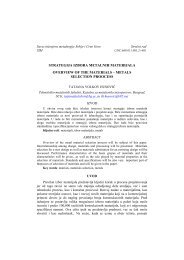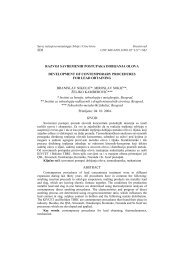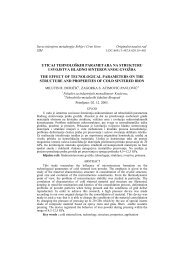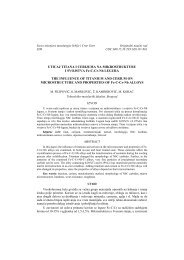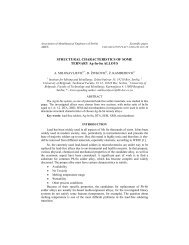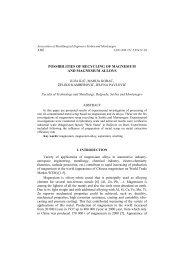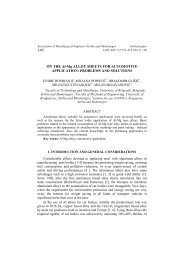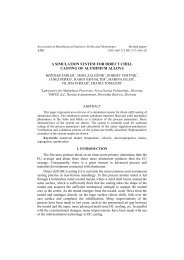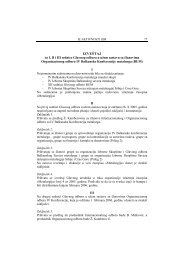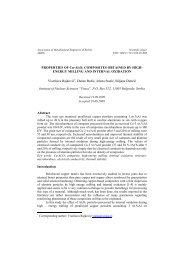THE INHIBITIVE EFFECT OF ETHANOLAMINE ON CORROSION ...
THE INHIBITIVE EFFECT OF ETHANOLAMINE ON CORROSION ...
THE INHIBITIVE EFFECT OF ETHANOLAMINE ON CORROSION ...
Create successful ePaper yourself
Turn your PDF publications into a flip-book with our unique Google optimized e-Paper software.
Jevremović et al. - The Inhibitive Effect of Ethanolamine on Corrosion... 243<br />
1 mm, purity 99.7 %). The exposed area of the coupon was 1 cm 2 . Platinum of 9 mm ×<br />
9 mm area was used as counter electrode and saturated calomel electrode as reference<br />
electrode. Before being immersed into the electrolyte the working electrode was<br />
polished with 600 grit emery papers, degreased with isopropyl alcohol and dried in air.<br />
All the experiments were carried out at 20 °C in stagnant conditions. Test solution was<br />
3 wt. % aqueous NaCl, deoxygenated by purging CO 2 gas for 1 h before the start of the<br />
experiment and during the whole test in order to maintain positive CO 2 partial pressure<br />
and remove dissolved oxygen. The basic inhibition properties of MEA (Fig. 1) on the<br />
CO 2 corrosion were investigated by injecting MEA in the solution after the bare<br />
aluminium corrosion tests had been conducted. Ethanolamine was added at following<br />
concentrations: 1 mM, 3 mM, 4 mM, 5 mM, 7 mM and 8 mM.<br />
Fig. 1. Molecular structure of the monoethanolamine (MEA)<br />
Electrochemical measurements<br />
All the electrochemical measurements were carried out using Reference 600 TM<br />
Potentiostat/Galvanostat/ZRA (Gamry Instruments, Inc., Warminster, PA, USA) while<br />
the impedance spectra were analyzed using Gamry Instruments Echem Analyst fitting<br />
program, version 5.50. Electrochemical impedance spectroscopy (EIS) and linear sweep<br />
voltametry (LSV) measurements were performed after 30 min of open circuit potential<br />
(OCP) measurements.<br />
The electrochemical impedance measurements were carried out over a frequency<br />
range of 10 kHz to 10 mHz using a 10 mV amplitude of sinusoidal voltage variation<br />
around the open circuit potential.<br />
The linear sweep voltametry measurements were carried out from a cathodic<br />
potential of -200 mV to an anodic potential of +200 mV with respect to open circuit<br />
potential with a scan rate of 1 mV/s.<br />
Weight loss measurement<br />
The weight loss was determined by weighing the cleaned samples before and<br />
after immersing into the test solution in the absence and presence of ethanolamine at<br />
following concentrations: 1 mM, 3 mM, 4 mM, 5 mM, 7 mM and 8 mM. The<br />
experiments were carried out in 3 wt. % aqueous NaCl at 20 °C in stagnant conditions.<br />
The solutions were deoxygenated by purging CO 2 gas during the whole experiment.<br />
After an immersion time of 24 h the cleaning procedure consisted of wiping the<br />
coupons with a paper tissue, washing with distilled water and isopropyl alcohol, the<br />
sample was then hot air dried and weight.<br />
Characterization of surface morphology<br />
A scanning electron microscope (SEM) JEOL JSM-5800 was used to analyze the<br />
morphology of the aluminium surface without and with inhibitor added. Images of the<br />
samples were recorded after 24 h exposure time in 3 wt. % aqueous NaCl saturated with<br />
CO 2 at 20 °C in stagnant conditions, without and with different concentration of<br />
ethanolamine added.




